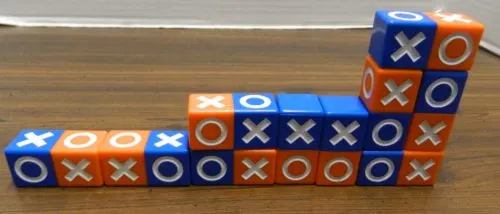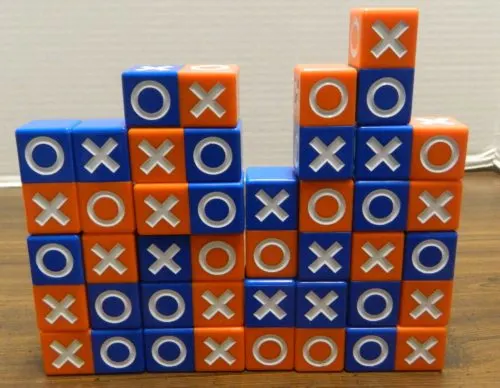In the past I have looked at several games that have tried to create their own twists on the Connect 4/Tic-Tac-Toe formula. Most of these games try to change how you place your symbols out on the board which usually ends up adding more luck to the game. Today I am looking at Brix which tweaks the formula by having every symbol/color connected to the opposite symbol/color. This makes every block that is played help both players at the same time. While this new mechanic might not revolutionize the genre, it actually makes Brix a better game than its’ inspiration, Connect 4.
How to Play Brix
Place all 22 blocks in the center of the table. Before beginning the game the players have to choose which way they are going to play the game since there are three different game modes in Brix.
- Game 1 X’s versus O’s: One player tries to get four X’s in a row while the other player tries to get four O’s in a row.
- Game 2 Blue versus Orange: One player tries to win by getting four blue in a row while the other tries to get four orange in a row.
- Game 3 Symbols versus Colors: One player tries to get four X’s or O’s in a row while the other player tries to get four orange or four blue in a row.
While playing Brix players take turns placing blocks. Players can place blocks vertically or horizontally. A player is not allowed to place a block that would extend the base wider than eight symbols. No block can be placed where part of the block hangs over an empty section of the wall. If the wall should ever be knocked down by a player, the other player automatically wins.

The block on the far left cannot be played since there are already eight blocks in the bottom row of the wall.
Whenever a player gets four of their symbol/color in a row vertically, horizontally, or diagonally they win the game. If both players win due to a block being played, the player who played the last block wins the game.
If all 22 blocks have been played and neither player has won the game, players take one block off the wall and place it somewhere else in the wall. A player cannot move the block that the other player just moved. Players keep moving one block on their turn until one player wins the game.

All of the blocks have been used so players will have to start taking blocks off and moving them to a new spot.
My Thoughts on Brix
Looking at Brix the first thing you will probably think of is Connect 4. That comparison is natural since the two games do share a lot in common. The goal in both games is to get four in a row. The blocks/disks are stacked on top of one another. Both games are really easy to play and have similar winning strategies. There is actually only one thing that really distinguishes the two games and that is the main reason why Brix is a better game that Connect 4.
That one unique mechanic in Brix is the idea of the dual sided blocks. In Connect 4 when you play a disk you are only adding a disk of your own color. When you play a block in Brix you are actually playing two colors/symbols. Every time you play a block you are hopefully helping yourself but at the same time you might be helping your opponent since one side of the block is your color/symbol while the other side can help your opponent.
Such a simple addition to the game actually changes the game more than you would think. The game is still played the same way as Connect 4 but the additional side for each block actually adds quite a bit of strategy since you need to pay attention to prevent helping your opponent get four in a row. Having two symbols/colors on each block adds quite a few different strategic options for players to create automatic win conditions. In Connect 4 the goal is to set up a situation where you have two sets of three in a row since the other player can’t block both of them in one turn. In Brix you have more options since you could create a situation where your opponent blocks one group but by blocking that group they help you create another group.
Basically Brix is a game that can give you as much strategy as you want. If you want a casual game you can just play blocks and see who wins without putting too much thought into where you place your blocks. If you want to form a strategy though there are plenty of options there as well.
That being said Brix is a game that will appeal to some players more than others. I played several games with my brother and we had differing opinions of the game. I thought the game was quite good while he thought it was pretty average. While we usually agree quite strongly on most games I understand the difference of opinion on Brix. In general I enjoy these spatial awareness games/puzzles considerably more than my brother does. I am also generally better at these type of games so I tend to usually win. Brix is a game where one player could end up winning most of the time if they are better at these type of games. Due to our differences of opinion on Brix, the final rating is more of an average of our two individual scores for the game.
While you only get one set of blocks, Brix actually has three different games/modes that you can play with the blocks. While they all have the same rules and gameplay, they actually play differently than I was expecting. The first two games are referred to as the basic games and are pretty much the same game. Basically the only difference is whether you want to use the symbols or colors. These two games play just like Connect 4 outside of having two symbols/colors on every block. Being the beginner games I would probably recommend these two games for children.
The more interesting game is colors versus symbols. While the gameplay is the same as the other games, the idea that you can win with two different colors or symbols makes the game more interesting. This mode adds more strategy to the game since you have more options since both sides of every block can be used to help you. Since you have two different ways to win it is also quite a bit harder to keep track of what your opponent is doing which makes the game feel more strategic. While the two more basic modes are still fun, I would probably recommend mostly playing the colors versus symbols game with teenagers and adults.
One small issue that I encountered while playing Brix is you usually reach a point where one player goes into offense mode where they can make several plays in a row that sets up groups of three. This forces the other player into placing blocks to prevent the other player from winning. Eventually the roles reverse if the defensive player is able to successfully block several turns in a row.
While this might be due to how we played the game, it happened multiple times so I am wondering whether this is just a side effect of having both symbols/colors on every block. This doesn’t ruin the game but it is kind of boring when one player’s move is basically dictated to them several turns in a row. In games like Connect 4 a player usually has one or two chances at getting four in a row and then they need to take a couple turns setting up their next chance at winning. In Brix it sometimes feels like you can keep trying turn after turn to get four in a row. I just wish Brix had a little more of the back and forth of Connect 4.
For people familiar with Blue Orange Games’ line of board games it shouldn’t come as much of a surprise that the components for Brix are quite nice. For a game that retails for around $15-$20 you couldn’t ask for much more out of the components. The game only comes with 22 blocks and the instructions but the blocks are really nice. The blocks are made of thick/sturdy plastic and should last for a very long time. I love that the game included such nice components since the game could have easily used much cheaper components.
Should You Buy Brix?
While Brix might have a lot in common with Connect 4, Brix is the superior game in my opinion. The simple idea of having two colors/symbols on every block adds more strategy to the game than you would think. Instead of just focusing on making your own groups of four and blocking the other player, you need to make sure you aren’t placing a block that will inadvertently help the other player. Brix is a good example of an easy to play game for the whole family that has enough strategy to keep adults interested.
Brix is not a perfect game though. The game tends to have an issue where one player stays on the offensive for several turns in a row while the other player has to play defensively. Brix is also the type of game that is not going to appeal to everyone. People who like these type of games will probably really enjoy Brix while people who don’t really like these type of games will probably find the game to be pretty average.
If you are a fan of spatial puzzle type games like Connect 4 and are looking for a new twist on the formula I think you will really enjoy Brix. If you don’t really care for this genre of games though, I don’t know if Brix does enough to change your mind.
We would like to thank Blue Orange Games for the review copy of Brix used for this review. Other than receiving the review copy we at Geeky Hobbies received no other compensation. Receiving the review copy had no impact on the content of this review or the final score.
If you would like to purchase Brix you can find it on Amazon.




